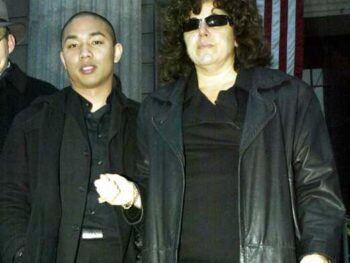Ambien users wake up, smell the lawsuits
POSTED: Wednesday, April 26th, 2006 at 1:00 am
BY: dmc-admin
Janet Makinen, a Florida housewife, was prescribed Ambien in 1998 for insomnia. About two weeks later, she began walking in her sleep to her kitchen and devouring food.
It didn’t matter what kind of food, either. Makinen, 55, of Dade City, Fla., wolfed down raw eggs, uncooked rice, cans of vegetables, loaves of bread, and bags of chips and candy.
An hour after her binge-eating, she’d wake up vomiting.
Makinen gained so much weight from the nocturnal feedings that she ballooned from a size 1 to a size 12. She still suffers from stomach problems, including an ulcer.
She stopped taking Ambien in 2005. And now she’s suing Sanofi-Aventis, the manufacturer of the popular prescription sleeping medication.
A class-action suit filed March 6 in U.S. District Court in the Southern District of New York claims that Ambien caused Makinen and hundreds of other users to enter into trance-like states in which they drove cars, binged on food and engaged in other activities they have no memory of.
The suit accuses Sanofi-Aventis of inadequately warning users of the dangers of amnesic sleep-eating, sleepwalking and sleep-driving.
New York attorney Susan Chana Lask, who filed the suit, said that in addition to damages, she wants the manufacturer to provide stronger warnings about Ambien’s potential dangers.
As of March 22, about 500 other plaintiffs had joined the suit.
Ambien was introduced to the market in 1993, but its sales have soared in the past few years — due mainly to an intensive consumer advertising campaign.
Last year, an estimated 26.5 million prescriptions were dispensed for Ambien — more than double the number written in 2001 — making it the nation’s best-selling prescription sleeping pill.
Lask said she first heard about the phenomenon of amnesic sleep-eating in an e-mail from Makinen.
“I thought it was just crazy,” Lask recalled. “Who sleep-eats?”
But she mentioned the e-mail to her legal assistant, who said that she, too, had done some somnambulistic food-foraging.
That’s when Lask began researching the possible side effects of Ambien, which turn out to include sleep-eating, sleepwalking and sleep-driving.
She discovered bizarre behavior is not uncommon: “They cook full meals, but they’re disgusting meals. They’re like zombies. They’re just shoving things in their mouths. It’s this carnal thing.”
And the strange behavior that some users exhibit in their sleepwalking states occasionally even lands them in jail — much to their surprise, since amnesia is another documented side effect.
Other plaintiffs named in the class-action suit include:
Judith Renee Lasswell, a Navy lieutenant in Florida who was arrested for shoplifting DVDs and a candle from her naval base. She does not recall the alleged thefts.
Her security clearance has been revoked, and she faces larceny charges and dishonorable discharge from the Navy.
Christina Brothers, a financial analyst who was prescribed Ambien for insomnia in May 2005. After three days of taking her prescribed dose, she woke up on the concrete floor of a jail cell. Brothers learned from a police report that she got out of bed around 6 a.m., left her house, drove her mother’s car into a parked vehicle, left the scene and ran into another vehicle. She left that scene as well, returned home, had a chat with her mother and was arrested in her bedroom later that morning.
She remembers neither the accident, nor anything else from the morning of her arrest.
Kathleen Callahan, a New York lab technician who claims there were mornings when she found her refrigerator door open, crumbs on the floor, chocolate icing on her hands and a ring of chocolate around her mouth. One morning she woke up in bed with her hands in a potato chip box.
Callahan also alleges she was twice sexually assaulted by a neighbor while in a sleepwalking state.
One New York pharmaceutical defense lawyer specializing in class actions, who asked not to be named, said he thinks it is unlikely the New York case will proceed as a class action, because physicians receive information about a medication from many different sources and it could be difficult to isolate the communications physicians had with the manufacturer.
Following the recent news reports, Sanofi-Aventis issued a statement saying that sleepwalking occurs in about 4 percent of the adult population, and that while “events of sleepwalking have occurred during treatment with Ambien, these instances cannot be systemically linked to the product.”
It also said that a recent company analysis concluded that the current prescribing information is accurate: “Somnambulism is a possible rare adverse event.”
The manufacturer also reminded users that Ambien should only be taken when the user can have eight hours of uninterrupted sleep, and that it should never be taken with alcohol.
The Food and Drug Administration says the drug’s current warnings are adequate.
David Benjamin, a toxicologist in Newton, Mass., said that while the strange side effects of Ambien are very believable, a product liability suit against the manufacturer faces an uphill challenge.
“The warnings say take the drug while you’re in bed, and don’t take it while you’re driving,” he noted.
That could make it difficult to prove a “failure to warn” claim, according to Benjamin.
The New York pharmaceutical defense lawyer suggested that Sanofi-Aventis’ possible liability for its warnings about the risk of sleepwalking may hinge on whether the company had documented the risk of Ambien-caused sleepwalking, and withheld it from physicians and consumers.
Benjamin also said that Ambien-impaired individuals arrested for criminal behavior could argue a “lack of intent,” claiming they had no intent to drive a car or engage in illegal activity.
On The Road Again
Attorneys who specialize in drunk-driving cases are already running into Ambien cases.
William Head, an attorney in Atlanta who specializes in DUI defense, has defended several drivers who landed in jail after sleep-driving episodes.
“You’re seeing people with not one blemish on their driving history suddenly charged with a series of ridiculous driving situations,” he said. “They don’t know they’re driving.”
Head recently defended a man in Decatur, Ga., who had several drinks and took two Ambien. The last thing he remembers is watching David Letterman on television.
He was arrested on multiple driving charges, including driving on the wrong side of the road. But a judge was unconvinced that Ambien was the cause of the man’s bizarre behavior, since he had also consumed alcohol. As a result, Head’s client was convicted of driving under the influence.
In a new case, Head is representing a Florida businessman who took Ambien but hadn’t consumed any alcohol or other medications. When Fulton County, Ga. police pulled him over for erratic driving, the man’s pants were down around his ankles.
“He took it [Ambien] in the morning,” Head said. “The next thing, he’s driving in the broad daylight with his pants down.”
Head said he plans on arguing the case before a jury, which he hopes to educate about the risk of sleep-driving while using Ambien.
“The key to me in these cases is if the person taking the medication had no prior episodes of sleepwalking or sleep-driving, then that’s a very good case,” Head said.
“Because [Ambien’s] packaging materials in no way indicate the symptoms of getting behind the wheel and not knowing you’re there.”
There has also been at least one Ambien-related airline arrest.
Sean Joyce, a British painting contractor, was on a flight from Charlotte, N.C. to London last July. He had taken an Ambien pill and drunk several glasses of wine when he got up, grabbed a young woman sitting next to him, started yelling and ripped his shirt off.
Joyce reportedly threatened to kill himself and everyone on the plane. He was handcuffed and the plane was diverted to Boston.
“He woke up in a jail cell in East Boston with absolutely no memory of what happened,” said Michael C. Andrews, an attorney in Boston who defended Joyce.
Andrews convinced federal authorities that Joyce’s aggressive behavior and amnesia were caused by Ambien.
Under a plea agreement, Joyce was sentenced to the five days he had already served.
Twilight Zone
Benjamin, the Massachusetts toxicologist, likened the bizarre effects of Ambien in certain individuals to those of benzodiazepines, such as Halcion and Xanax.
“Somehow, they affect the brain adversely and people have this dissociative reaction where they do weird things that they don’t remember,” he said.
“We’ve known about these types of effects for date-rape drugs,” he said. “This is a very, very similar reaction.”
Ambien is classified as a non-benzodiazepine hypnotic.
William R. Johnson, a chemist at the Wisconsin State Laboratory of Hygiene, who studied Ambien-impaired drivers in Wisconsin over a six-year period, said it’s not clear why Ambien causes sleepwalking in some users. But he theorized that they may partially awaken after four or five hours of sleep.
“When you get beyond that four-hour period, in some people the medication loses some of its effect and it allows them to become semi-awake, but not conscious,” he said.
Sanofi-Aventis has recently released a timed-release sleeping pill, AmbienCR, aimed at maintaining a full eight hours of sleep.
Life In The Slow Lane
Many states don’t test for Ambien when making impaired-driving arrests. But in some state toxicology labs, Ambien is among the top 10 drugs found in impaired drivers.
The Wisconsin study identified Ambien in the bloodstreams of 187 drivers arrested from 1999 through 2004. More than half of the Ambien-impaired drivers also tested positive for alcohol, and nearly half tested positive for other drugs, including benzodiazepines such as Valium, Xanax and Klonopin.
In 21 cases where Ambien was the only drug found, driving behavior ranged from hitting light poles to running over curbs to driving in the wrong lane.
The main characteristic of Ambien-impaired drivers was that they drove well below the speed limit and kept driving until they hit something, according to Johnson.
“The slow speed was very common, and essentially driving until you couldn’t drive anymore. They tended to run into a stationary object, like a light pole or parked car,” he said.
In five cases in which no alcohol or other drugs were found, Johnson said, police reported that the Ambien-impaired drivers shared the same zombie-like characteristics.
“They seemed very much disoriented; their eyes wouldn’t focus on individuals,” he said. “They would just look right through a person.”
This article originally appeared in Lawyers Weekly USA, a sister publication of Wisconsin Law Journal.









